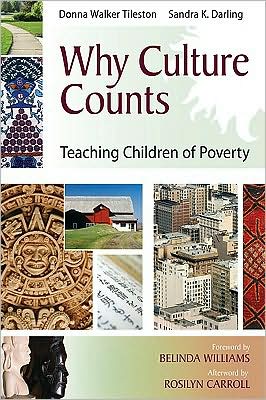

 |

|

Sold Out
Book Categories |
About the Authors xi
Foreword xiii
Introduction 1
Culture and Poverty 7
Deficit Models Don't Work 8
A New Differentiation Model for Culture and Poverty 9
Differentiating Context 9
Differentiating Content and Product 10
Differentiating Process 11
Poverty in America 12
Some Consequences of Poverty 14
How Do We Define Poverty in Education? 14
Poverty and Race 18
The Good News 19
What We Can Do 20
Summary of Chapter One 21
Differentiating for Economically and Culturally Diverse Learners 23
Why Do We Need Another Differentiation Model? 24
What's Missing in Traditional Differentiation Models? 25
Differentiating Instruction Using a Research-Based Model 27
Summary of Chapter Two 30
Building Teacher Background Knowledge 31
Collectivist vs. Individualist Values 31
Not Understanding Value Systems Has Consequences 32
Understanding Value Systems Has Great Benefits 34
Vocabulary and Crystallized Intelligence 35
Crystallized vs. Fluid Intelligence 36
High Expectations 37
What Must We Do? 39
Summary of Chapter Three 39
Planning to Differentiate 41
Mrs. Jones's Third-Grade Language Arts Class 42
Preteaching Vocabulary 43
Contextualizing Content and Classroom for Culture 45
Modifying Instructional Strategies 47
Planning Differentiation for a Secondary-School Classroom 51
Preteaching Vocabulary 51
Providing Personal Objectives 52
Grouping Students 52
Summary of Chapter Four 53
Differentiating Context 55
What Is a Culturally Responsive Teacher? 56
Creating a Culturally Responsive Classroom 57
The Learning Environment Is Inviting 57
The Community Leader Sends Inviting Messages 58
The Teacher Applies Firm, Consistent, and Loving Control 58
Students Believe They Can Accomplish the Tasks Asked of Them 59
The Community Stresses Collectivity Rather Than Individualism 59
Instructional Strategies for Culturally Responsive Classrooms 59
Cooperative Learning 60
Group Investigation 61
Graphic Representations 62
Call and Response 63
Wait Time 64
Visual Imagery 64
Affirmations 65
The KIVA Process 65
The Culturally Responsive Classroom 66
The Culturally Responsive African American Classroom 66
The Culturally Responsive Mexican American Classroom 71
A Checklist for Culturally Responsive Environments 75
Summary of Chapter Five 76
Differentiating Content and Product 79
Differentiating Content 79
Relevance 80
Rigor 96
Relationships 102
Differentiating Product 103
From the Simple to the Complex: Bloom's Taxonomy 104
Rubrics 107
Summary of Chapter Six 108
Differentiating Process 109
The Self System-Do I Want to Do It? 111
The Metacognitive System-How Will I Do It? 112
The Cognitive System-How Will I Make Meaning Out of It? 113
The Impact of Systems of Thinking on Diverse Learners 114
Self-System Strategies 116
Metacognitive System Strategies 118
Cognitive System Strategies 123
Summary of Chapter Seven 140
Differentiating Assessment 141
When Assessments Make a Difference 143
Checking for Understanding of What's Been Taught 144
A High School Literature Assessment 145
Choral Response to Questioning at a Middle School 146
Buddy Support at an Elementary School 146
Cooperative Learning Groups-Practicing for Formative Assessment 147
Aligned Assessment 148
Triangulating for Alignment 149
Assessing for Type of Knowledge 152
Assessment as a Learning Tool-Mrs. Cabral's Classroom 157
Identifying the Misconceptions 157
Error Analysis 158
Student Choice and Voice in Assessment 159
Multiple Intelligences 159
Individual vs. Collaborative Work 160
Summary of Chapter Eight 161
Bringing It Together to Build Resilience in Diverse Students 163
Fostering Resilience 164
How to Use the Two Rubrics 167
Instructional Needs Rubric 168
Differentiation Steps Rubric 168
Summary of Why Culture Counts 169
Afterword 181
References 185
Login|Complaints|Blog|Games|Digital Media|Souls|Obituary|Contact Us|FAQ
CAN'T FIND WHAT YOU'RE LOOKING FOR? CLICK HERE!!! X
 You must be logged in to add to WishlistX
 This item is in your Wish ListX
 This item is in your CollectionWhy Culture Counts: Teaching Children of Poverty
X
 This Item is in Your InventoryWhy Culture Counts: Teaching Children of Poverty
X
 You must be logged in to review the productsX
 X
 X

Add Why Culture Counts: Teaching Children of Poverty, Poverty alone is not the cause of low achievement in our schools. Using careful research, Why Culture Counts shows why it is vital to take into account the needs, beliefs, and values that children of poverty and diverse learners bring to class every day. , Why Culture Counts: Teaching Children of Poverty to the inventory that you are selling on WonderClubX
 X

Add Why Culture Counts: Teaching Children of Poverty, Poverty alone is not the cause of low achievement in our schools. Using careful research, Why Culture Counts shows why it is vital to take into account the needs, beliefs, and values that children of poverty and diverse learners bring to class every day. , Why Culture Counts: Teaching Children of Poverty to your collection on WonderClub |